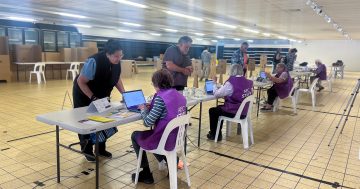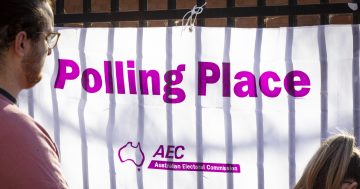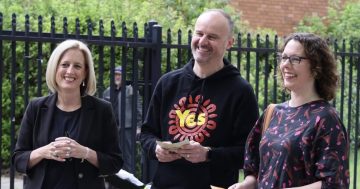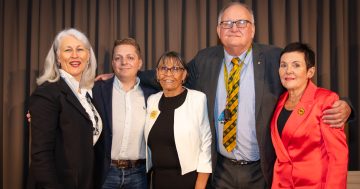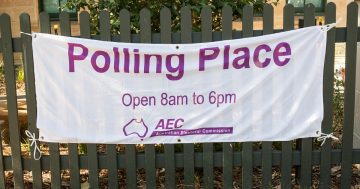
Statues of the first women to federal parliament, Dorothy Tangney and Enid Lyons, were decorated with ‘Yes’ badges. Photo: Michelle Kroll.
The ACT is the only jurisdiction in the country that has voted Yes to enshrining an Indigenous Voice to Parliament in the referendum.
While counting is still underway, and it could take a few more days for the Australian Electoral Commission to release an official result, enough has been tallied to show that Australia has rejected Indigenous constitutional recognition.
Chief Minister Andrew Barr made no secret that he wanted the Territory to return the highest Yes vote in the country.
He issued a statement saying Australians have had their say and that had to be respected.
“I hope that Canberrans who are saddened by the national result can take some heart that our community strongly voted Yes,” Mr Barr said.
“The ACT has proved once again that we are the most inclusive and progressive jurisdiction in Australia.
“We are the progressive heart of the nation.”
He acknowledged a “vast majority” of referendums in the past have failed, but took heart that the debate in the Territory was “largely conducted without anger and hate”.
“This result should not stop us on our journey towards Reconciliation, including the important work under the National Agreement on Closing the Gap,” Mr Barr said.
“In the months and years ahead, there will be a period of reflection. It is essential that there is national healing. This may take some time.”
The Canberra Liberals MLAs were able to make their own decisions on how to vote, with leader Elizabeth Lee hoping for a Yes outcome.
She said the outcome was a “very disappointing result” for many.
“Thank you Canberra for voting ‘yes’,” Ms Lee said.
“Governments at all levels must continue to take action to improve the lives of our First Nations people.
“This is not the end but a reminder that we must do better.”
In the ACT, 316,837 people are enrolled to vote, with 258,009 votes counted as of 8 am (Sunday, 15 October).
The Yes vote stands at 60.84 per cent in the Territory, with 39.16 per cent voting No.
Counts are ongoing across the rest of the country, including across the Capital Region.
As of 8 am, the votes in the Capital region electorates stand at:
- Hume: 26.13 per cent Yes, 73.87 per cent No, with 69 out of 71 polling places counted
- Eden-Monaro: 39.84 per cent Yes, 60.52 per cent No, with 84 out of 89 polling places counted
- Gilmore: 38.16 per cent Yes, 61.84 per cent No, with 63 out of 68 polling places counted
The national vote stands at 39.75 per cent for Yes and 60.25 per cent for No.
While zero out of six states have a majority for the Yes vote.
For the referendum to pass, the proposed alteration must be approved by both a national majority of voters and a majority of voters in a majority of the states (at least four out of the six states).
This is known as a double majority, which is needed for any referendum to pass.
This means votes from both the ACT and Northern Territory only count towards the overall national vote.
Votes from Norfolk Island residents are included as part of the ACT electorate of Bean.
Friday (13 October) was the biggest single day of pre-polling in Australia’s history with just over one million votes cast.
Overall about 6.13 million people input their ballots at an early voting centre, making this referendum pre-poll the largest in Australia’s history.
For comparison, 5.6 million votes were cast at early for the 2022 federal election.
Meanwhile about 2.1 million people applied for a postal vote, compared to 2.7 million at the 2022 federal election, while 135,000 people voted via an AEC mobile polling team and 47,000 people voted at a polling place overseas.
In total, early voting (postal and in-person) adds up to 8.41 million, meaning about 9.2 million people needed to cast their votes on Saturday (14 October).












